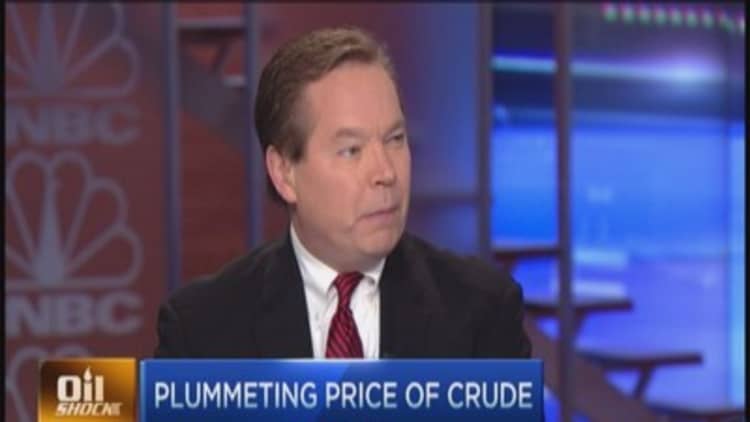The ruble looked set for its steepest one-day fall since the Russian financial crisis of 1998 on Monday, plunging more than 6 percent against the dollar before recovering to losses of around 4 percent.
Russia's central bank may have started to intervene on the foreign exchange market to curb ruble losses, three traders said on Monday.
"It may have been central bank," a trader at a Western bank told Reuters. The central bank declined to comment.
Early Monday, the ruble was down 3.9 percent at 52.45 against the dollar and 3.8 percent lower at 65.39 against the euro, hitting fresh record lows.
The dollar-based RTS stock index was down 3.1 percent to 944 points, having touched a five-year low of 930. In contrast the ruble-based MICEX, which benefits from a weaker ruble, was up 2.1 percent to 1,571 points, a 2014 high.
Read MorePutin seeks toreassure world amid 'perfect storm'
Oil benchmark Brent futures were hovering just above a five-year low, at $69.6 per barrel, weighed down by weak manufacturing data from China and last week's decision by OPEC not to cut oil production to support prices.
OPEC's shock decision means markets are increasingly pricing in the likelihood of cheap oil for an extended period, causing a fundamental reassessment of Russian asset prices, analysts said.
Oil and gas account for about two thirds of Russia's exports and half of federal budget revenues, making its economy and asset prices heavily dependent on global energy prices.
The ruble crashed through the psychologically significant, and until recently unthinkable, level of 50 against the dollar on Friday, bringing its losses since mid-year to 35 percent.
Read MoreThis bearish indicator just neared its pre-crash high
"Support for the ruble at present can only come from stabilization of the oil price. Other factors now look secondary and of little significance," Globex Bank senior trader Igor Zelentsov said in a note.
He said market expectations that the central bank would intervene when the ruble hit 50 against the dollar "have lost their actuality in connection with the sharp and substantial change in the price of oil," noting that at current oil prices the ruble was likely to weaken to the 53-55 range.
Standard Bank analyst Tim Ash said in a note that he was surprised by the lack of central bank intervention since its decision to float the ruble last month.

"Logically one only has to conclude that the weaker ruble is part of the Russian authorities' policy responses to lower oil prices and sanctions (over Ukraine) as it helps prop up growth and helps keep the budget on track by boosting the ruble value of dollar oil revenues," he said in a note.
Read MoreCan oil fall all the way to $40?
The central bank has not intervened in the foreign exchange market since it floated the ruble on Nov. 10, saying it would do so only if it considered the ruble's fall a threat to financial stability.
"Well, let's see if the current collapse of the ruble is considered such a threat," Profit investment house head analyst, Gleb Zadoya, said in a morning note.


